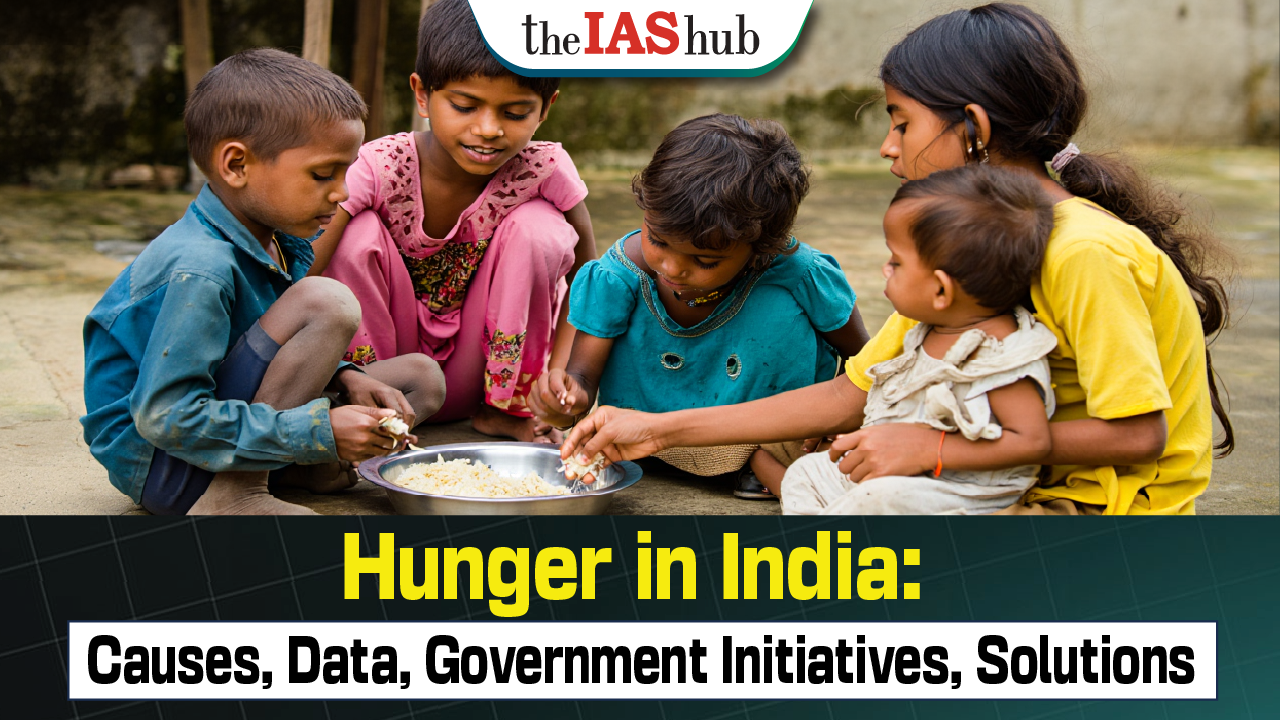Explore the hunger crisis in India—its causes, alarming statistics, and government initiatives like POSHAN Abhiyan and NFSA. Learn strategies for tackling malnutrition, ensuring food security, and achieving SDG 2: Zero Hunger by 2030.


|
“You might not feel it in the belly, but it strikes at the core of health and vitality” UNICEF |
Hunger is defined by the United Nations as the period when people experienced severe food insecurity—meaning that they go for entire days without eating due to lack of money, access to food, or other resources. Poverty and hunger are the two sides of same coin.


|
Hunger Alleviation Programs in India |
Features |
|
Eat Right India Movement |
Outreach activity by FSSAI to promote healthy eating habits |
|
POSHAN Abhiyan |
Aims to reduce stunting, undernutrition, and anaemia among children and women |
|
Mid-day Meal (MDM) scheme |
Improves nutritional levels among school children, promoting enrolment, retention, and attendance |
|
Pradhan Mantri Matru Vandana Yojana |
Maternity benefit program for pregnant women |
|
Food Fortification |
Addition of key vitamins and minerals to staple foods to enhance nutritional content |
|
National Food Security Act, 2013 |
Entitles a percentage of the population to receive subsidized food grains |
|
Mission Indra Dhanush |
Immunization program targeting children under 2 years and pregnant women against 12 diseases |
|
Integrated Child Development Services (ICDS) Scheme |
Offers services to children (0-6 years), pregnant women, and lactating mothers |
Eliminating Hunger: Sustainable Development Goal 2 is about creating a world free of hunger by 2030.
Even though concerted efforts are going on to fulfill SDG 2 which calls for zero hunger, it is time for a focused approach towards combating malnutrition to reach the Global Nutrition targets by 2025 (WHO) and build a thriving and productive human capital.


Refine your answer writing skills and elevate your UPSC preparation with personalized support and expert feedback.
Fill out the form to get started with the program or any other enquiries !








Are you dreaming of becoming an IAS officer? Then, IAShub can be your best guide. It is one of the Best IAS Coaching in Delhi. Many students who want to clear the UPSC exam join IAShub for learning. The institute gives both online and offline classes. Their teachers are experienced and helpful. They easily explain every topic. Students also get notes, tests, and tips to do well in the exam.
IAShub is in Delhi and is trusted by many UPSC students. It offers coaching for every part of the UPSC exam – Prelims, Mains, and Interview. The classes are simple and easy to understand. The teachers are experts and guide students in the right way. IAShub is also known for its helpful notes, test series, and answer-writing practice. IAShub is the best coaching in Delhi and also gives UPSC Online Classes. This helps students from any place in India to learn. The online classes are live and also recorded. So, students can watch them anytime. These classes cover the full UPSC syllabus.
Here are some important services provided by IAShub:
The UPSC Civil Services Exam has three parts:
This exam is tough, but with the right guidance, it becomes easy to manage. Students must study smart and stay regular.
IAShub supports students from the beginning to the end. It gives the right books, tests, and notes. The classes are easy to follow, and the teachers are always ready to help. Students get personal doubt sessions too. The test series and answer checking help students learn where they need to do better. Also, free study materials save time and money.
IAShub also guides students during the final stage – the interview. Experts take mock interviews and give useful tips. This full support makes IAShub one of the best IAS coaching in Delhi.